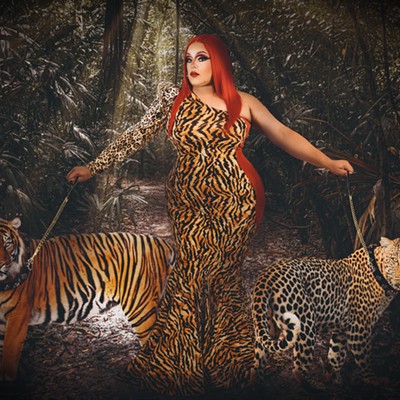When Ned Farr wrote the screenplay for his full-length feature film The Gymnast, he wanted to showcase the many talents of his wife, Dreya Weber.
Weber is an actress, gymnast, aerialist and musician. Farr also is multitalented, and is a writer, director, musician and visual artist.
The Gymnast has been earning awards at film festivals across the country, and will be screened at the upcoming Savannah Film Festival. It tells the story of Jane Hawkins, a former top gymnast whose career ended before she could compete in the Olympics.
Almost 20 years have passed, and Jane is now trapped in a passionless marriage with an overbearing husband. She has been trying to get pregnant against her husband’s wishes, but is told by her doctor she may have waited too long to have children.
When a chance encounter with a former gymnastic teammate provokes Jane to re-examine her life, she visits a gym, where she is recognized by a coach. The coach recruits her to become an aerialist for an Cirque Du Soleil-type aerial act, and Jane finds a new passion.
Also recruited for the act is Serena, an enigmatic dancer. As Jane and Serena put the act together, they begin to fall in love.
Will Jane return to her husband, who is suddenly willing to have a child? Or will she create a completely new life for herself?
“As the story came into focus, I certainly didn’t have any meta-position on its place in the social or cultural continuum, aside from the dead certainty that at no time is it a good idea to make a film about a woman in her forties,” Farr says. “This is the conventional wisdom of the industry, anyway.
“Clearly, I benefit from most other filmmakers running in the opposite direction -- I have the playing field all to myself, and an opportunity to turn the conventional wisdom on its head,” he says. “So perhaps this film is timely if it will help fill a void. There’s a billion women in their forties and up. Don’t they get to see themselves as heroes, too?”
Farr wanted to feature Weber and her talents as an actor and aerialist. “The ‘job’ of an aerialist is not something I’ve come across on film, so it seemed like an opportunity to give people a window into a world they probably haven’t seen much of,” Farr says. “That was the first goal, so I knew there was going to be a story that used aerials as a backdrop.
“Since we had almost no budget, the assets available to us dictated other major character elements,” he says. “For instance, having access to a mansion in Malibu with a pool and an indoor theater was the genesis for the Denise character, as well as many plot points.
“If I’d have had access to a bank instead, she’d have ended up a banker, and perhaps Serena would have been a teller,” Farr says. “I’m a big fan of working with limitations, as they force you to come up with solutions that are usually more creative. So it wasn’t so much inspiration as engineering.”
The film has many interwoven themes. “One of the biggest themes for me concerns the issue of infidelity,” Farr says.
“It’s a marvel how vilified adulterers are in real life, and how much grace audiences in turn give an adulterous character in film life, simply because they can virtually experience the infidelity themselves,” he says. “Think of The Thorn Birds, or Bridges of Madison County. The fact that this issue never comes up fortifies my suspicion that there’s an inherent dishonesty in the sexual mores of our culture.
“There’s something about sexuality and relationships and marriage that won’t fit into the ‘happily ever after’ box, and the result is the dichotomy I’ve just described,” Farr says. “Not that I’m complaining. The tension is what makes the romance work.”
The theme of aging also is a major part of the film. “The threshold a woman crosses when she can no longer give birth and what that does to her sense of worth, purpose, and self, fuels another big theme for me, which is the profound idea of rebirth,” Farr says.
“If people leave the theater feeling like there’s a potential second or third act to their lives, that they too can choose to drive toward a new world and not look back, then we’ve succeeded,” he says. “Some might even be motivated to simply get back into shape. I’d like to add that an added benefit would be if they left the theater a little more tolerant in their views on sexuality.”
The technical difficulties of shooting on such a low budget were many, but Farr was able to work around them. “The real challenge I faced every day was not to let the drama turn into melodrama,” he says.
“I found myself cutting dialog and letting scenes play more in what wasn’t said, or pushing for complexity in emotion through simplicity in performance or camera coverage,” Farr says. “And when you’re not using stunt doubles or safety harnesses, it becomes quite a challenge to get the aerial performances and shot angles before the actors become exhausted and in danger of falling.”
Both Weber and Addie Yungmee, who plays Serena, were dancers on Cher’s Farewell Tour. “I would tag along for weeks at a time,” Farr says.
“We spent many hours talking about character development and scenes that would reveal character,” he says. “This continued through rehearsals and the shoot, so that what you see is the product of a collaboration.
“Though madness was always swirling around the production, Dreya and Addie were usually the calm in the storm,” Farr says. “Thankfully, Dreya and I made a good husband and wife team, probably because she thought of me as the director and I thought of her as the talent.
“Dreya is a marvel,” he says. “A Variety reviewer, in referring to her performance, called her ‘a master of the speaking glance.’ So true.
“Addie had never done a movie before,” Farr says. “In fact, she’d never really had any acting experience at all, which makes her performance even more remarkable. She’s quite simply a natural.
“My primary direction to her, and to everyone in fact, was simply to do less,” he says. “A blank expression is never really blank, not only because the soul is ever present in the eyes, because also the viewer tends to fill in the emotion themselves.”
Farr never intended to become a filmmaker. “I was originally a visual artist and planned on becoming a painter,” he says. “I got into film school as a fluke, but decided to try it out, thinking running around outside with a camera would be more fun then sniffing oil paints in a loft. I think I was right.
“When I left film school, I pursued music for a time,” Farr says. “I had a terrific band and I’m very proud of the two albums we made. Both records were concept albums, with every song adding to a larger story -- clearly I was a frustrated filmmaker!”
You can hear one of Farr’s recordings, Desert Motel, on iTunes. “It was through music that I met Dreya, so it was a good detour,” he says.
When the couple met, Weber also had a band. “We played music together,” she says. “We were both involved with other people, but stayed in touch.”
They’ve found a common interest in filmmaking. “We’ve made four short films together,” Weber says. “As soon as digital technology became available, we made The Catcher about a haunted trapeze. The next one we made at our first apartment. When we moved into a house, we made the next on in the garage.
“The Gymnast is an extension of that philosophy,” Weber says. “The aerial elements were shot at our house. When you do independent films, you have to do what you can.”
The film seems to strike a chord in viewers. “People are very uplifted and inspired by this movie,” Weber says. “It addresses women’s value, their self-esteem and self-worth. It also asks, ‘Can we be physical beings after a certain age?’
“We’re underdogs. This movie has no stars. It’s about women. The main character falls in love with another woman. We are about as much of an underdog as we can be,” Weber says.
“A business person would say, ‘Don’t make this movie,’” she says. “Also ‘Make Serena a man.’ But when you make an independent film, you can tell the story as it’s meant to be told.” ç
The Gymnast screens Sunday Oct. 29 at 11:30 a.m. at the Trustees Theatre and Wednesday Nov. 1 at 2:30 p.m. at the Lucas Theatre.
























